Most of us have been enjoying it since childhood, happily eating it without much thought - but just what is Nougat? Ask your friends and they'll say something like: "It's that weird tan goo inside candy bars" - and they're right... but how is it made and where does it come from? You might assume that Nougat is produced by candy manufacturers, and that's partially correct. But much like the chocolate that often surrounds it, the main ingredient of Nougat (called Nugat) has roots in the tropical jungles of the globe's southern hemisphere.
 Nougat's story begins in a remote region of
east-central
Africa which is
almost completely uninhabited by humans because of the dense forests
and dangerous rocky mountain slopes. This region known as Nugati
lies just north of Kingi, which is shown here on the map. Nugati's
combination of rain forest-like valleys surrounded by steep, arid
mountains creates a unique climate that's found nowhere else on Earth.
It is believed that this climate is the reason that Nugat trees flourish here on the sunny mountain tops,
yet grow only sparsely elsewhere (the tree will not grow at all above the equator). The Nugat tree will
produce
brilliant red flowers every March which last until September when the valuable seed-bearing pods appear.
Nougat's story begins in a remote region of
east-central
Africa which is
almost completely uninhabited by humans because of the dense forests
and dangerous rocky mountain slopes. This region known as Nugati
lies just north of Kingi, which is shown here on the map. Nugati's
combination of rain forest-like valleys surrounded by steep, arid
mountains creates a unique climate that's found nowhere else on Earth.
It is believed that this climate is the reason that Nugat trees flourish here on the sunny mountain tops,
yet grow only sparsely elsewhere (the tree will not grow at all above the equator). The Nugat tree will
produce
brilliant red flowers every March which last until September when the valuable seed-bearing pods appear.
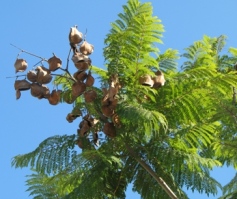 Nugat pods |
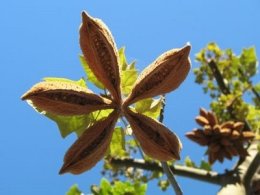 Nugat blossom |
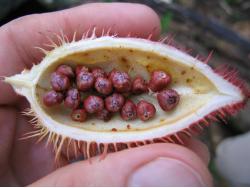 Nugat seeds |
On their own however, the Nugat trees could not survive. The tree secretes a powerful acid which
makes the leaves unappetizing to the region's hungry caterpillars which can reach 10 inches in length and
would otherwise devour the foliage, killing the trees. When the summer rains wash over the leaves, it
carries some of this acid to the ground directly under the trees. This makes the soil pH so low that the
Nugat seeds can not germinate there. Fortunately, the trees have friends in the valley below.

Panoramic view of the Nugati valley
For reasons which are not clearly understood, every other harvest season, the gorillas which inhabit the Nugati Valley ascend into the mountains. Below the Nugat trees, the gorillas congregate. Here they remain for 2-3 weeks, feasting on the fallen Nugat seed pods. They will often shake the trees, causing more of the ripe pods to fall. As the gorillas feast they sometimes play or fight, carrying or even throwing the spent pods about. Of course some uneaten seeds remain in these pods, and those which are scattered far enough from the existing trees' acidic soil can germinate thus propagating the otherwise doomed Nugat trees. Because the gorillas are a protected species, commercial pod harvesting is only permitted after the gorillas return to the valley, and of course anytime during the seasons when the gorillas do not ascend.
 Gorillas migrate from the valley |
 Gorillas play and throw Nugat pods |
This unusual arrangement works very well however. Both the trees and the gorillas continue to flourish.
The chart illustrates the two-year average Nugat seed harvest, and production has actually increased in
recent years.
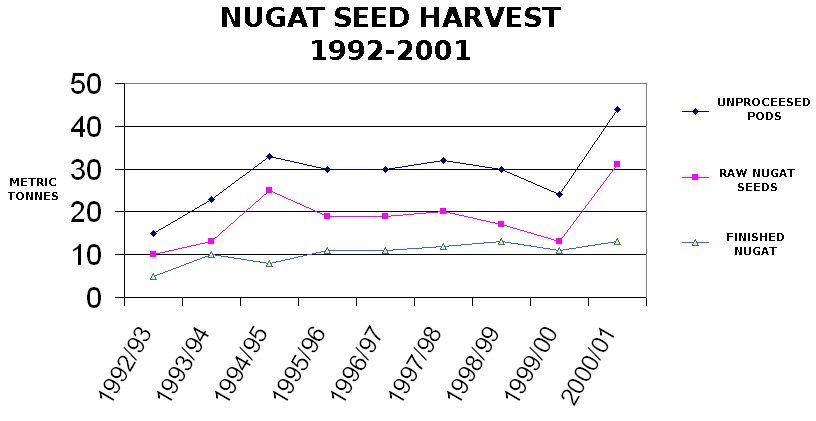
Only 1-2 ounces of Nugat seed paste is required to make 50 pounds of what we know as "Nougat". Sugar, egg
whites and other ingredients make up the bulk of the candy's mass. Below are shown images of raw Nugat
seed paste, a native resident preparing a batch of Nugat in the traditional way, and finally images more
familiar to us such as production at a modern candy factory.
 Raw Nugat paste |
 Traditional production method |
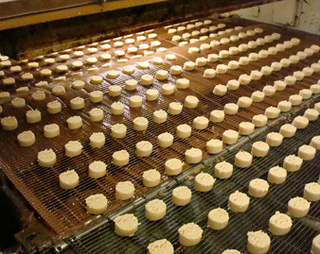 Commercial nougat production |
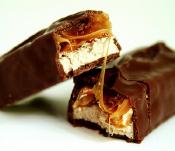 Candy bar containing nougat |
So now you know! Next time some one asks you "What IS nougat anyway?", you can impress them with
your complete knowledge of the subject.